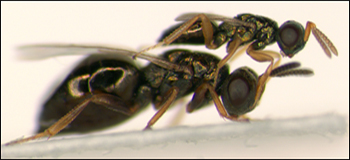Research Brief: Meet <i>Drosophila</i>’s Stinging Sister, <i>Nasonia</i>
Quick Links
Drosophila geneticists with an interest in neurodegeneration can now avail themselves of a new insect model. As reported in tomorrow’s Science, an international research team led by John Werren of the University of Rochester, New York, has sequenced the genomes of three species of Nasonia parasitic wasps. One-fourth the size of a fruit fly, wasps are still a cinch to rear in the lab but afford better opportunities to study complex genetic traits and diseases involving many interacting genes.

What’s Not to Love?
Male wasps, like the one pictured here (on top) during courtship, have just one copy of each gene, making Nasonia a good insect model for studying multigene human traits and disorders. Image credit: Michael Clark, University of Rochester
As haplodiploid organisms, Nasonia males hatch from unfertilized eggs and carry just one set of chromosomes. This feature makes it easier to pin down mutant genes because their effects are not masked by the second allele. Furthermore, unlike fruit flies, wasps have all three types of DNA methyltransferase, which help determine which genes get turned on and off. This should aid studies in epigenetics, which have been increasingly linked to AD (e.g., Bjornsson et al., 2008 and ARF related news story; Wang et al., 2008 and ARF related news story; Mastroeni et al., 2009 and ARF related news story) and related disorders (e.g., Palsdottir et al., 2008 and ARF related news story).—Esther Landhuis.
References
News Citations
- Party of Three: Genes, Environment, and Epigenetics
- Drifting Toward AD—Epigenetic Changes Linked to Disease
- Twin Study Suggests Epigenetic Differences in AD
Paper Citations
- Bjornsson HT, Sigurdsson MI, Fallin MD, Irizarry RA, Aspelund T, Cui H, Yu W, Rongione MA, Ekström TJ, Harris TB, Launer LJ, Eiriksdottir G, Leppert MF, Sapienza C, Gudnason V, Feinberg AP. Intra-individual change over time in DNA methylation with familial clustering. JAMA. 2008 Jun 25;299(24):2877-83. PubMed.
- Wang SC, Oelze B, Schumacher A. Age-specific epigenetic drift in late-onset Alzheimer's disease. PLoS One. 2008;3(7):e2698. PubMed.
- Mastroeni D, McKee A, Grover A, Rogers J, Coleman PD. Epigenetic differences in cortical neurons from a pair of monozygotic twins discordant for Alzheimer's disease. PLoS One. 2009;4(8):e6617. PubMed.
- Palsdottir A, Helgason A, Palsson S, Bjornsson HT, Bragason BT, Gretarsdottir S, Thorsteinsdottir U, Olafsson E, Stefansson K. A drastic reduction in the life span of cystatin C L68Q carriers due to life-style changes during the last two centuries. PLoS Genet. 2008 Jun;4(6):e1000099. PubMed.
Further Reading
Annotate
To make an annotation you must Login or Register.

Comments
No Available Comments
Make a Comment
To make a comment you must login or register.